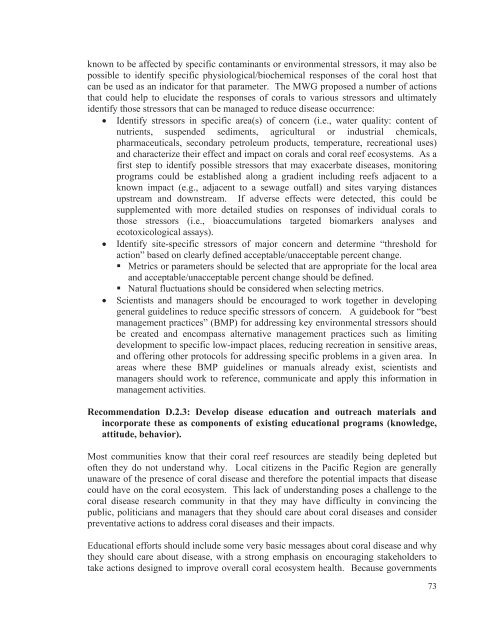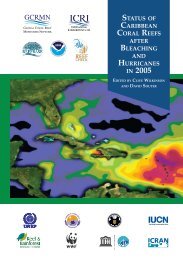Coral Health and Disease in the Pacific: Vision for Action
Coral Health and Disease in the Pacific: Vision for Action
Coral Health and Disease in the Pacific: Vision for Action
Create successful ePaper yourself
Turn your PDF publications into a flip-book with our unique Google optimized e-Paper software.
known to be affected by specific contam<strong>in</strong>ants or environmental stressors, it may also bepossible to identify specific physiological/biochemical responses of <strong>the</strong> coral host thatcan be used as an <strong>in</strong>dicator <strong>for</strong> that parameter. The MWG proposed a number of actionsthat could help to elucidate <strong>the</strong> responses of corals to various stressors <strong>and</strong> ultimatelyidentify those stressors that can be managed to reduce disease occurrence: Identify stressors <strong>in</strong> specific area(s) of concern (i.e., water quality: content ofnutrients, suspended sediments, agricultural or <strong>in</strong>dustrial chemicals,pharmaceuticals, secondary petroleum products, temperature, recreational uses)<strong>and</strong> characterize <strong>the</strong>ir effect <strong>and</strong> impact on corals <strong>and</strong> coral reef ecosystems. As afirst step to identify possible stressors that may exacerbate diseases, monitor<strong>in</strong>gprograms could be established along a gradient <strong>in</strong>clud<strong>in</strong>g reefs adjacent to aknown impact (e.g., adjacent to a sewage outfall) <strong>and</strong> sites vary<strong>in</strong>g distancesupstream <strong>and</strong> downstream. If adverse effects were detected, this could besupplemented with more detailed studies on responses of <strong>in</strong>dividual corals tothose stressors (i.e., bioaccumulations targeted biomarkers analyses <strong>and</strong>ecotoxicological assays). Identify site-specific stressors of major concern <strong>and</strong> determ<strong>in</strong>e “threshold <strong>for</strong>action” based on clearly def<strong>in</strong>ed acceptable/unacceptable percent change. Metrics or parameters should be selected that are appropriate <strong>for</strong> <strong>the</strong> local area<strong>and</strong> acceptable/unacceptable percent change should be def<strong>in</strong>ed. Natural fluctuations should be considered when select<strong>in</strong>g metrics. Scientists <strong>and</strong> managers should be encouraged to work toge<strong>the</strong>r <strong>in</strong> develop<strong>in</strong>ggeneral guidel<strong>in</strong>es to reduce specific stressors of concern. A guidebook <strong>for</strong> “bestmanagement practices” (BMP) <strong>for</strong> address<strong>in</strong>g key environmental stressors shouldbe created <strong>and</strong> encompass alternative management practices such as limit<strong>in</strong>gdevelopment to specific low-impact places, reduc<strong>in</strong>g recreation <strong>in</strong> sensitive areas,<strong>and</strong> offer<strong>in</strong>g o<strong>the</strong>r protocols <strong>for</strong> address<strong>in</strong>g specific problems <strong>in</strong> a given area. Inareas where <strong>the</strong>se BMP guidel<strong>in</strong>es or manuals already exist, scientists <strong>and</strong>managers should work to reference, communicate <strong>and</strong> apply this <strong>in</strong><strong>for</strong>mation <strong>in</strong>management activities.Recommendation D.2.3: Develop disease education <strong>and</strong> outreach materials <strong>and</strong><strong>in</strong>corporate <strong>the</strong>se as components of exist<strong>in</strong>g educational programs (knowledge,attitude, behavior).Most communities know that <strong>the</strong>ir coral reef resources are steadily be<strong>in</strong>g depleted butoften <strong>the</strong>y do not underst<strong>and</strong> why. Local citizens <strong>in</strong> <strong>the</strong> <strong>Pacific</strong> Region are generallyunaware of <strong>the</strong> presence of coral disease <strong>and</strong> <strong>the</strong>re<strong>for</strong>e <strong>the</strong> potential impacts that diseasecould have on <strong>the</strong> coral ecosystem. This lack of underst<strong>and</strong><strong>in</strong>g poses a challenge to <strong>the</strong>coral disease research community <strong>in</strong> that <strong>the</strong>y may have difficulty <strong>in</strong> conv<strong>in</strong>c<strong>in</strong>g <strong>the</strong>public, politicians <strong>and</strong> managers that <strong>the</strong>y should care about coral diseases <strong>and</strong> considerpreventative actions to address coral diseases <strong>and</strong> <strong>the</strong>ir impacts.Educational ef<strong>for</strong>ts should <strong>in</strong>clude some very basic messages about coral disease <strong>and</strong> why<strong>the</strong>y should care about disease, with a strong emphasis on encourag<strong>in</strong>g stakeholders totake actions designed to improve overall coral ecosystem health. Because governments73
















